| Pilgrim Places
| |||||
"There is no journey of discovery greater than that of looking within"
~ Kiran Nagarkar (Cuckold) The Blue Mountain Express that cuts across the heart of Tamil Nadu from Chennai makes its final halt at Mettupalayam. I, however, get off at the previous station, Coimbatore Junction, and am on my way to a place that has caught my attention. At 5.30 in the morning, the nip in the air is refreshing. I breathe in deeply and am excited about this journey. Annapoorna, the goddess of food has cast her blessings and lent her name to an enormous chain of restaurants in this city. Not able to resist the wafting aroma of freshly brewed coffee, I pay my respects to the goddess. The breakfast is as good as her name suggests.
|
More on Tamil Nadu • Overview • Chennai
Travelogues
Pilgrimages | ||||
'Isha Yoga Centre: 0.8 kms', the board reads. I pull my rucksack further up my haunches and start walking. It is a badly weathered dirt road; its bumps and trenches proof of the hard hitting rains in the forest area. The scent of the Eucalyptus tickles my nose and as I head further down the dirt road, the different scents of the forest has my olfactory organs in delight. I close my eyes and breathe deeply tucking the scent away into the crevices of my memory. At the end of the dirt road, a clearing leads up to a large open gate. The horizon is at hands' reach. A huge brick dome greets my eye and beyond it, the utter stillness of the Velliangiri hills that rest on the horizon beckons with an allure so strong that I cannot draw my gaze away from them. The temple dome calls me too, its silent invitation as irresistible as the call of the mountains.
I leave my bags and my shoes with a volunteer near the gates and proceed further to wash my feet under the cold water from the taps. The woman who greets me at the entrance is dressed in white and hands me a pamphlet.
I reach a vaulted tunnel at the end of the Parikrama and the tingle up my spine has taken a character of its own. It leaps and sings and I cannot move. There is something about this temple that demands your complete humility. A verse from K. Satchidanandan's poem, 'How to enter the Tao temple' flashes into my mind:
Don't lock the door.
Go lightly like the leaf in the breeze along dawn's valley. If you are too fair cover yourself with ash If too clever, go half-asleep. That which is fast will tire fast: be slow, slow as stillness. Be formless like water. Lie low, don't even try to go up. Don't go round the diety. Nothingness has no directions, no front nor back. Don't call It by name, Its name has no name. No offerings: empty pots are easier to carry than full ones. No prayers too: desires have no place here.
I am gently ushered into a crevice in the circular wall. I look around at the marbled floor, the triangular ventilators that run all around, the many similar niches that punctuate the wall, the magnificent huge dome and the cool Jalaseema, the water body, that surrounded the Dhyanalingam. An enormous feeling of quietness envelops me and I close my eyes. Not in prayer, not in entreaty or invocation. I feel my eyes brim with tears. They spill and pour and run down my cheeks and as much as my mind tells me to cut it out, they flow. My logic cannot fathom this strangeness. Yet I know when I open my eyes that nothing was, or ever will be the same as before.
The Dhyanalingam I learn is the distilled essence of yogic science. It is a wonder both in the physical and metaphysical senses. The physical aspects are tangible and perceptible by the sheer architectural and artistic magnificence of the Lingam and the temple. In the metaphysical sense, the Dhyanalingam is a Guru with an energy of tremendous proportions. Here, the transformation of an individual from the limited to the resplendent can happen in an instant. The monks who maintain the temple and call themselves Ishas tell me that the Dhyanalingam is not just another temple but a tremendous spiritual possibility. Its presence is not bound by time and space. It is also one of the few temples in India where women take care of its maintenance for 15 days of the month.
As the Velliangiri hills drench in the saffron sunset and I get on the last bus heading back for Coimbatore, I know that this is not my last journey here. The Dhyanalingam will always beckon me.
|
|||||
Editor: Romola Butalia (c) India Travelogue. All rights reserved. |
|||||
 The town bus stand is packed with early travellers. All destinations are written in Tamil and I quickly jump into one that says Poondi. "Isha," I request the burly, moustached conductor as I extend seven rupees for my ticket. The bus winds through the city and then heads westward outside of it. Past the Perur temple, large sugarcane and paddy fields bounce across my window as the rickety bus swirls and twists at an alarming speed. The horizon is soon dotted by small hills, which rise to reveal the Velliangiri Mountains. The rolling swell of the bluish mountains as seen through the light haze of the morning mist is unreal. A page from a book. I remember a friend who asked me once whether I would prefer to live by the sea or the mountain. When I see the sea, it is my sure choice but when I see the mountains, I lose my heart to its grandeur. A mountain by the sea would do well, I think smilingly as the bus tossed me up and down.
The town bus stand is packed with early travellers. All destinations are written in Tamil and I quickly jump into one that says Poondi. "Isha," I request the burly, moustached conductor as I extend seven rupees for my ticket. The bus winds through the city and then heads westward outside of it. Past the Perur temple, large sugarcane and paddy fields bounce across my window as the rickety bus swirls and twists at an alarming speed. The horizon is soon dotted by small hills, which rise to reveal the Velliangiri Mountains. The rolling swell of the bluish mountains as seen through the light haze of the morning mist is unreal. A page from a book. I remember a friend who asked me once whether I would prefer to live by the sea or the mountain. When I see the sea, it is my sure choice but when I see the mountains, I lose my heart to its grandeur. A mountain by the sea would do well, I think smilingly as the bus tossed me up and down. 
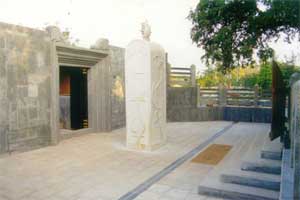 In a little over an hour, the conductor nods at me and says 'Isha Maiyam'. I gather my rucksack and alight from the bus as he shouts, "last bus - 6 0'clock evening." The bus turns a corner and I stand alone in front of a board nailed to a tree trunk.
In a little over an hour, the conductor nods at me and says 'Isha Maiyam'. I gather my rucksack and alight from the bus as he shouts, "last bus - 6 0'clock evening." The bus turns a corner and I stand alone in front of a board nailed to a tree trunk.
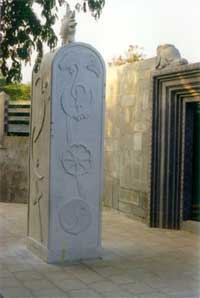 I stand rooted feeling a delicious tingle go up my spine. Why was I here? Do all the people and places we encounter in our life form a link to us through our past lives? Is our whole life a checkered game, the moves already in automated position by a predetermined design? One might ponder over all the mysteries of life, argue endlessly about the nature of the free will, and decide one way or the other on the existence of a karmic design. To me however, it is the perfect answer, a doctrine so irrefutable that sometimes the hopelessness of this karmic binding drives one to undertake that journey, the inward one, which is the only path that holds the promise of liberation. Was I here because this place initiated that path?
I stand rooted feeling a delicious tingle go up my spine. Why was I here? Do all the people and places we encounter in our life form a link to us through our past lives? Is our whole life a checkered game, the moves already in automated position by a predetermined design? One might ponder over all the mysteries of life, argue endlessly about the nature of the free will, and decide one way or the other on the existence of a karmic design. To me however, it is the perfect answer, a doctrine so irrefutable that sometimes the hopelessness of this karmic binding drives one to undertake that journey, the inward one, which is the only path that holds the promise of liberation. Was I here because this place initiated that path?
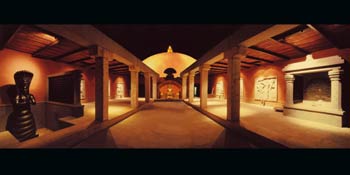 The entrance into the dome is through an unusual sunken reception. I descend and in the middle stands a tall, white granite monolith. The pamphlet tells me that it is the Sarvadharma Sthamba. Sculptural symbolic reliefs of the major religions of the world are etched on the Sthamba. The seven chakras of the human body, representing different levels of consciousness are inscribed on the back of the Sthamba. A sun carved in stone crowns the Sthamba symbolizing the peak of consciousness.
The entrance into the dome is through an unusual sunken reception. I descend and in the middle stands a tall, white granite monolith. The pamphlet tells me that it is the Sarvadharma Sthamba. Sculptural symbolic reliefs of the major religions of the world are etched on the Sthamba. The seven chakras of the human body, representing different levels of consciousness are inscribed on the back of the Sthamba. A sun carved in stone crowns the Sthamba symbolizing the peak of consciousness.
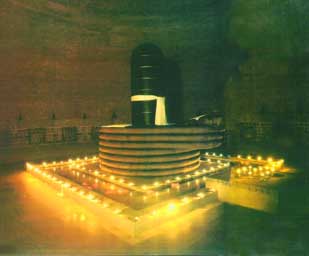 Beyond the Sthamba, is the main open pathway to the temple. I climb three high steps from the sunken reception into the main Parikrama. This pathway is open to the sky and as I enter I am struck by how austere, yet complete in aesthetics, the design of the temple is. A magnificently carved granite Patanjali, the father of Yoga, the half man, half snake figure held my gaze as he rose from the sunken shrine on the left. Vanashree, a sculptural relief of the peepal tree with a gold leaf carved in the middle drew me to the right of the pathway. Right up to the main arch leading into the dome, the Parikrama has six astounding stone-carved depictions of the life of south Indian saints.
Beyond the Sthamba, is the main open pathway to the temple. I climb three high steps from the sunken reception into the main Parikrama. This pathway is open to the sky and as I enter I am struck by how austere, yet complete in aesthetics, the design of the temple is. A magnificently carved granite Patanjali, the father of Yoga, the half man, half snake figure held my gaze as he rose from the sunken shrine on the left. Vanashree, a sculptural relief of the peepal tree with a gold leaf carved in the middle drew me to the right of the pathway. Right up to the main arch leading into the dome, the Parikrama has six astounding stone-carved depictions of the life of south Indian saints.
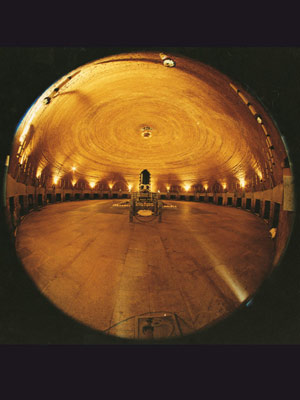 There are some things in the world that completely incapacitate language. Try as we might, we arrive only upon a shadow of the real thing in describing it. The towering Dhyanalingam standing before me is one such. It defies all definitions of beauty, stillness, and grandeur. Standing 13 feet, 9 inches tall, gleaming in black polished granite, wearing seven copper rings as its only adornment and resting on the seven- coiled Avudaiyar base, it was simply glorious. I could hear the softness of the breath I drew and released. And the resonating sound of the single water drop that fell on the Lingam at regular intervals from a copper dome on the ceiling.
There are some things in the world that completely incapacitate language. Try as we might, we arrive only upon a shadow of the real thing in describing it. The towering Dhyanalingam standing before me is one such. It defies all definitions of beauty, stillness, and grandeur. Standing 13 feet, 9 inches tall, gleaming in black polished granite, wearing seven copper rings as its only adornment and resting on the seven- coiled Avudaiyar base, it was simply glorious. I could hear the softness of the breath I drew and released. And the resonating sound of the single water drop that fell on the Lingam at regular intervals from a copper dome on the ceiling.
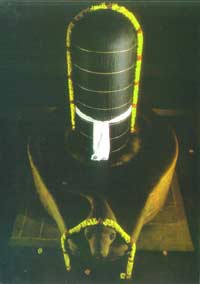 Perhaps after 15 minutes, possibly longer, one lost sense of time within that space, I come out of the temple. I needed to know more. The history, the reason, the whys, the whos and all the hows. And in getting these answers, I find an invitation to the unboundedness.
Perhaps after 15 minutes, possibly longer, one lost sense of time within that space, I come out of the temple. I needed to know more. The history, the reason, the whys, the whos and all the hows. And in getting these answers, I find an invitation to the unboundedness.
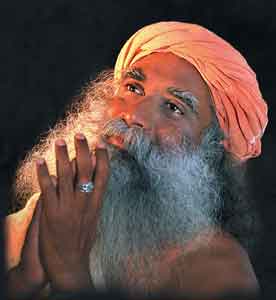 In tracing its genesis, I find that it is the only fully consecrated Dhyanalingam in the world. An unfinished one exists in Bhojpur, Madhya Pradesh. The visionary and the spiritual architect of this magnificent form is Sadhguru Jaggi Vasudev. An Enlightened Master who lives in the small ashram set up around the temple states simply, " This life for me is an endeavour to help people manifest their divinity. The very purpose of life is to reach the highest possible flowering. Dhyana or meditation is the path to flowering and the Dhyanalingam prepares every being for this voyage. It offers the possibility to every individual to embark on a spiritual
In tracing its genesis, I find that it is the only fully consecrated Dhyanalingam in the world. An unfinished one exists in Bhojpur, Madhya Pradesh. The visionary and the spiritual architect of this magnificent form is Sadhguru Jaggi Vasudev. An Enlightened Master who lives in the small ashram set up around the temple states simply, " This life for me is an endeavour to help people manifest their divinity. The very purpose of life is to reach the highest possible flowering. Dhyana or meditation is the path to flowering and the Dhyanalingam prepares every being for this voyage. It offers the possibility to every individual to embark on a spiritual